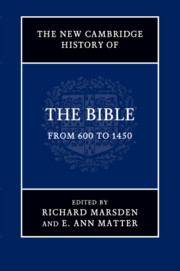Book contents
- Frontmatter
- Contents
- Figures
- Contributors
- Preface
- Abbreviations
- Abbreviations of books of the Bible
- Table of Psalm numbering
- Introduction
- Part I Texts and Versions
- Part II Format and Transmission
- Part III The Bible Interpreted
- Part IV The Bible in Use
- 34 The Bible in the medieval liturgy, c. 600–1300
- 35 The use of the Bible in preaching
- 36 The Bible in the spiritual literature of the medieval West
- 37 Literacy and the Bible
- 38 The Bible and canon law
- 39 The Qurʾān and the Bible
- Part V The Bible Transformed
- Bibliography
- Index of biblical manuscripts
- Index of scriptural sources
- General index
- References
34 - The Bible in the medieval liturgy, c. 600–1300
from Part IV - The Bible in Use
Published online by Cambridge University Press: 28 May 2012
- Frontmatter
- Contents
- Figures
- Contributors
- Preface
- Abbreviations
- Abbreviations of books of the Bible
- Table of Psalm numbering
- Introduction
- Part I Texts and Versions
- Part II Format and Transmission
- Part III The Bible Interpreted
- Part IV The Bible in Use
- 34 The Bible in the medieval liturgy, c. 600–1300
- 35 The use of the Bible in preaching
- 36 The Bible in the spiritual literature of the medieval West
- 37 Literacy and the Bible
- 38 The Bible and canon law
- 39 The Qurʾān and the Bible
- Part V The Bible Transformed
- Bibliography
- Index of biblical manuscripts
- Index of scriptural sources
- General index
- References
Summary
The essays in the present volume reveal how the Bible was transmitted, studied, interpreted and visually embellished in the Middle Ages. Medieval monks, clergy and laity (insofar as the latter understood Latin) did not encounter the Bible primarily as written text, however, but through its proclamation during Mass and Office. Every day psalms were chanted and passages from the Hebrew scriptures and the New Testament were read, along with patristic commentaries on them. Over the course of a year, a monastic community would have heard a large part of the Bible. At Mass selected passages from the Gospels, Epistles and (mainly during Lent) the Old Testament were read according to a prescribed annual cycle. Almost all the texts of the Proper chants of the Mass were drawn from the Bible, principally the book of Psalms.
The chapter ‘The Bible and the early liturgy’ in the first volume of the present series cites evidence for the use of biblical texts in the liturgy of New Testament times and the patristic era. Precise details are difficult to come by, however, given the disappearance of whatever ‘liturgical’ books might have existed in the first centuries of the Christian era. In the present chapter, for practical reasons, the Office and the Mass will be treated separately. The use of the Bible in regional western rites (Gallican, Milanese) and in the eastern liturgies can be mentioned only in passing. For the structure of Mass and Office reference will be made to specialised studies.
- Type
- Chapter
- Information
- The New Cambridge History of the Bible , pp. 659 - 679Publisher: Cambridge University PressPrint publication year: 2012
References
Accessibility information
- 2
- Cited by

